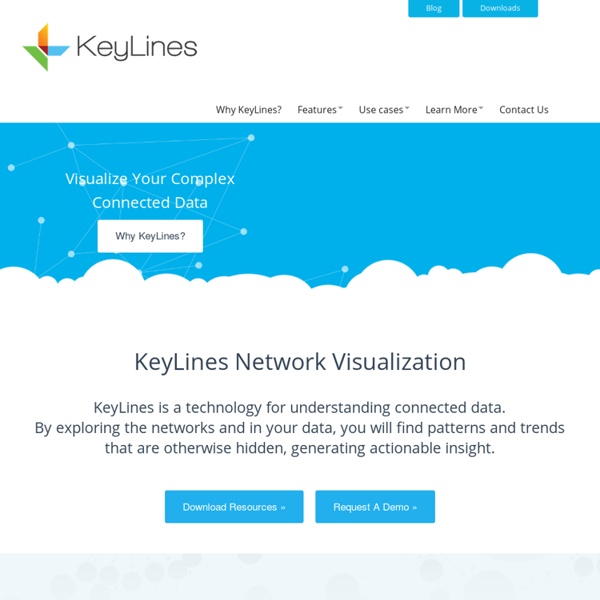



Data Visualization Software Lab - Data visualization JavasScript library for adding interactive touch-screen driven charts and graphs to your web site (Javascript and HTML5 SDK) Javascript Territory - Jster Javascript Catalog BrainMap Looking 4 data visualization: Tools . RAW est une nouvelle application web ouverte et gratuite qui permet de créer aisément des dataviz basées sur le framework D3.js de Mike Bostock (Data Designer au New York Times). . Développé par l'institut de recherche italienne Density Design, l'outil permet de générer sans aucune ligne de code des visualisations avancées de type Treemap, Dendogram, Fineo Diagram. . 6 types de layouts / composants graphiques sont disponibles à ce jour : Treemap, Bubble Chart, Dendogram, Hexagonal Binning, Alluvial Diagram (Fineo), Circle Packing. . . 'raw is conceived to ease graphic production, not to replace it.
Cytoscape.js This is how easy it is to get started with Cytoscape.js (this code creates the instance you see on the bottom-right: About Cytoscape.js is an open-source graph theory library written in JavaScript. Cytoscape.js allows you to easily display and manipulate rich, interactive graphs. Cytoscape.js also has graph analysis in mind: The library contains a slew of useful functions in graph theory. Cytoscape.js is an open-source project, and anyone is free to contribute. The library was developed at the Donnelly Centre at the University of Toronto. Cytoscape.js & Cytoscape Though Cytoscape.js shares its name with Cytoscape, Cytoscape.js is not Cytoscape. Cytoscape.js is a JavaScript library: It gives you a reusable graph widget that you can integrate with the rest of your webapp with your own JavaScript code. Funding Funding for Cytoscape.js and Cytoscape is provided by NRNB (U.S. ISB | UCSD | MSKCC | Pasteur | Agilent | UCSF | Unilever | Toronto | NCIBI | NRNB Architecture & API Notation Position Data
The Top 10 Javascript MVC Frameworks Reviewed - CodeBrief UPDATE 1/14/2012: Added Batman.js and Angular.js due to popular demand and because they looked impressive. Over the last several months I have been in a constant search for the perfect javascript MVC framework. Driven by a dire need for the right level of abstraction and features, I have tried out - some more cursorily than others - every framework I could get my hands on. Here lies a brief synopsis of each framework. Lastly, I share the framework which I ultimately decided on. Specifically, the following four features are very important to me: UI Bindings - I'm not just talking about templates, I'm talking about a declarative approach to automatically updating the view layer when the underlying model changes. The Contenders Here is a table showing all of the frameworks support for the above features. 1. Backbone.js is the web's darling framework. Pros: Strong community and lots of momentum. Cons: Lacks strong abstractions and leaves something to be desired. 2. Pros: Bindings support. 3.
FreeMind If you’re disappointed with big data, you’re not paying attention There has been a backlash lately against big data. From O’Reilly Media to the New Yorker, from Nassim Taleb to Kate Crawford, everyone is treating big data like a piñata. Gartner has dropped it into the “trough of disillusionment.” It might be provocative to call into question one of the hottest tech movements in generations, but it’s not really fair. Correlation versus causation versus “what’s good enough for the job” One of the biggest complaints — or, in some cases, proposed facts — about big data is that is relies more on correlation than causation in order to find its vaunted insights. Honestly, for song or product recommendations, who really cares? But in areas like medicine, finance and even marketing, people are becoming much more concerned with finding out “why” once they’ve found out “what.” Or if you’re a retail store, knowing that Mac users who visit your site tend to buy more-expensive products might make you want to show them more-expensive products.
Flare | Data Visualization for the Web Superheroic JavaScript MVW Framework Mind Map Diagram to visually organize information A mind map is a diagram used to visually organize information into a hierarchy, showing relationships among pieces of the whole.[1] It is often created around a single concept, drawn as an image in the center of a blank page, to which associated representations of ideas such as images, words and parts of words are added. Major ideas are connected directly to the central concept, and other ideas branch out from those major ideas. Mind maps can also be drawn by hand, either as "notes" during a lecture, meeting or planning session, for example, or as higher quality pictures when more time is available. Buzan's specific approach, and the introduction of the term "mind map", started with a 1974 BBC TV series he hosted, called Use Your Head.[6] In this show, and companion book series, Buzan promoted his conception of radial tree, diagramming key words in a colorful, radiant, tree-like structure.[7] Differences from other visualizations [edit]
6 Great Interactive Data Visualization Tools (Part 2) Welcome back for the second part of my series on interactive data visualization (dataviz) tools. In part one, we covered three cool tools for visualizing charts and graphs and many other data types on a webpage. In part two, we take a look at three more tools that are a bit more complex but have some incredible data visualization capabilities. 4. Exhibit is a very robust and customizable offering. Visualization Types Supported: Line Graphs, Maps, Scatter Plots, Multi-Filterable Lists, Timelines, Timeplots and more…with widgets! Flexible & Powerful Approach to Design I really like the approach of Exhibit, where data is presented through a "lens" – an HTML template shell that elements are placed into. Steep Learning Curve Like the other more complex libraries, there is more coding involved with Exhibit than most options, and having previous Javascript experience is definitely very helpful. 5. Javascript InfoVis Toolkit is a nice suite of tools for creating charts and graphs on a webpage.